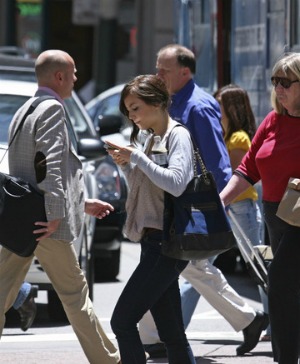Walking to work this morning, I saw a shocking thing that is no longer shocking: On Fifth Avenue, during crowded Christmas week, with traffic piling up into almost a jam and pedestrians everywhere, many jay-walking, the traffic cop on the beat at the intersection of Fifth and 53rd was tapping away on her smart phone, paying no attention whatsover to the mounting troubles around her.
 I shouldn’t have been surprised, I guess — not in an age when, according to an article in published in The New York Times on Dec. 15,
I shouldn’t have been surprised, I guess — not in an age when, according to an article in published in The New York Times on Dec. 15,
…doctors and nurses can be focused on the screen and not the patient, even during moments of critical care. And they are not always doing work; examples include a neurosurgeon making personal calls during an operation, a nurse checking airfares during surgery and a poll showing that half of technicians running bypass machines had admitted texting during a procedure.
…[it’s] a problem perhaps best described as “distracted doctoring.”
Today’s Wall Street Journal had an article about a new effort in theater:
…Last week, the Public Theater announced–via Twitter, naturally–that it would make 25 seats available for live tweeting during the first performance of “Gob Squad’s Kitchen” in January. And at the Circle in the Square Theatre, the lead producer of “Godspell” is considering a secluded section of “tweet seats.” …And it comes at a time when other self-indulgent audience habits have become standard. Grown men and women hide their in-show texting like 14-year-olds. Ring tones are ubiquitous–just ask Patti LuPone. As for food, Broadway theaters have allowed snacks and drinks for years, and people crunch and munch through Lincoln Center performances all the time.
It was just about two years ago, I recall, that I joked that performing arts centers should set aside areas for people who wanted to use their Blackberries and iPhones and even computers during performances. Who knew it would shortly become a reality?
Not for nothing has the Blackberry long been known as the “crackberry.” Experts everywhere say that we’re becoming addicted to our devices.
Cell phones used to be forbidden in museums, too. Now they serve as audioguides — and that’s a good thing, as long as they are not used for conversations that everyone can hear. Now we have everyone tweeting everywhere, as they walk around observing. If they’re quiet, that too is ok. But I lament the trend toward participatory art museums IF it means we are going to lose the atmosphere of inquiry and contemplation that museums offer.
I’m not — I stress — calling for museums to be as quiet as a tomb. But, without forbidding the use of devices, I’d like to see museums offer refuge from our devices. Device ettiquette should be enforced.
And, yes, exhibitions have to be that compelling.
